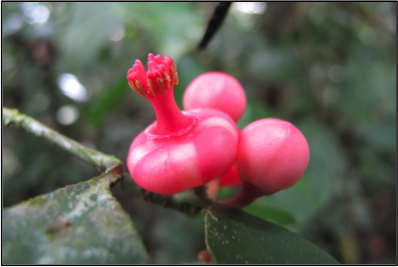Potential pollinators of understory populations of Symphonia globulifera in the Neotropics.
DOI:
https://doi.org/10.26786/1920-7603(2018)oneAbstract
One difference between the forest canopy and the understory is that animals pollinate the majority of understory species in the tropical wet forest. Pollinators active in the understory are also different from those in the forest canopy and are adapted to the mesic conditions underneath the canopy. We used video cameras to observe flowers of understory Symphonia globulifera (Clusiaceae) in tropical wet forests of Costa Rica. We quantified the timing, frequency and behaviour of flower visitors to explore their potential contribution to pollination. A total of 82 flower visits were observed during 105 h of observations. Flowers were visited by ten insect species and one hummingbird species; the most active time period was between 1200-1700 h followed by the time between 0500-1000 h. The time period with fewer visitors was 1700-2200 h, during this period we observed flowers visited in multiple instances by a bushcricket (Tettigoniidae). The most frequent flower visitors were the stingless bee Tetragonisca angustula and the hummingbird Phaethornis longirostris; both came in contact with anther and stigma during visits. We observed different flower visitors from those reported for canopy populations of S. globulifera. Insects predominated, in contrast to observations in canopy populations of S. globulifera, wherein perching birds predominated. We also documented the consumption of pollen by visiting insects. These findings highlight differences in flower visitors between the forest canopy and the understory for the same tree species and contribute to better understanding of the pollination ecology of understory tropical wet forest species.

Downloads
Published
How to Cite
Issue
Section
License
Copyright (c) 2018 Andre Sanfiorenzo, Manuel Sanfiorenzo, Ronald Vargas Castro, Lisette Waits, Bryan Finegan

This work is licensed under a Creative Commons Attribution 4.0 International License.
JPE is an open access journal which means that all content is freely available without charge to the user or his/her institution.
Authors who publish with this journal agree to the following terms:
1) Authors retain copyright and grant the journal right of first publication with the work simultaneously licensed under a Creative Commons Attribution License that allows others to share the work with an acknowledgement of the work's authorship and initial publication in this journal.
2) Authors are able to enter into separate, additional contractual arrangements for the non-exclusive distribution of the journal's published version of the work (e.g., post it to an institutional repository or publish it in a book), with an acknowledgement of its initial publication in this journal.
3) Authors are permitted and encouraged to post their work online (e.g., in institutional repositories or on their website) prior to and during the submission process, as it can lead to productive exchanges, as well as earlier and greater citation of published work (See The Effect of Open Access).
To assure a broader targeted audience, content will be included into databases (such as EBSCO) and directories (such as DOAJ).











